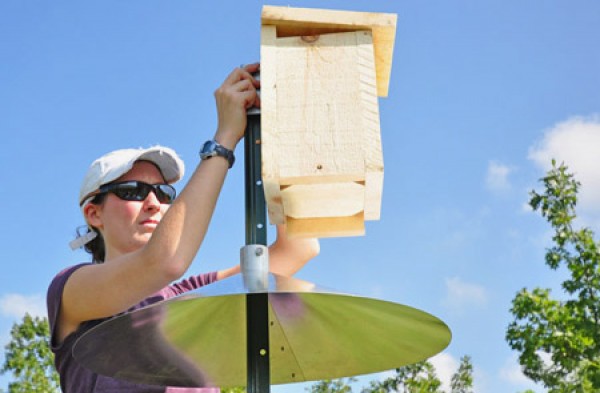If you build it, they will come.
That’s the hope of a team from the Department of Biological Sciences who installed 51 nest boxes at the University’s Pelee Environmental Research Centre on Saturday, August 27, to attract tree swallows, a blue-and-white species of songbird that breeds in the area.
“Tree swallows are an important part of our local bird community and they are excellent study animals,” said biology professor Dan Mennill, an ornithologist who helped to organize the project.
The project is the first of its kind for the University of Windsor. It will allow local scientists to contribute to continent-wide research.
“Field biologists across North America study tree swallows,” said biology professor Stéphanie Doucet. “Research on this species has lead to major breakthroughs on topics that range from the breeding behaviour of animals, to the effects of climate change, to the influence of environmental toxins. With our own study population, we will collect local data that will be important at a continental scale.”
In addition to providing new opportunities for research and teaching, the nesting birds will provide direct benefits to humans, Dr. Mennill said.
“Tree swallows have big appetites for mosquitos and other flying insects,” he said. “They fly large distances each day eating the insects that we think of as pests. They fly over streams and small water bodies, but also right through the backyards of Essex County.”
The team that set up the 51 nest boxes included six professors from the Faculty of Science--Daniel Heath, Dennis Higgs, Trevor Pitcher and Kirsten Poling in addition to Mennill and Doucet-- as well as 11 graduate students and helpers.
“Setting up the tree swallow grid was a great learning opportunity,” said Kara-Anne Ward, a graduate student finishing her master’s degree in biology. “I learned about the process of properly designing and establishing this type of research site. It was a fun experience which will be useful in my future career.”
The grid of tree swallow nest boxes is part of a wave of local projects undertaken by UWindsor biologists. Over the coming years, researchers will develop further projects at several locations around Essex County, including Saturday’s site, a 23-acre property donated by the Municipality of Leamington.
“We’re developing a network of interconnected research sites and research projects that, together, we call the Pelee Environmental Research Centre,” said Dr. Heath. “Setting up the tree swallow nest boxes is the first step in this exciting development. The project involves new partnerships between the University of Windsor, the Municipality of Leamington, and many other local groups and stakeholders.”
The research team will not be able to measure the success of Saturday’s work until the arrival of tree swallows during spring migration, said Mennill.
“We’ve built the nest boxes,” he said. “Now we wait for the birds to come.”
See more photos of the installation work on Mennill's Web site.

